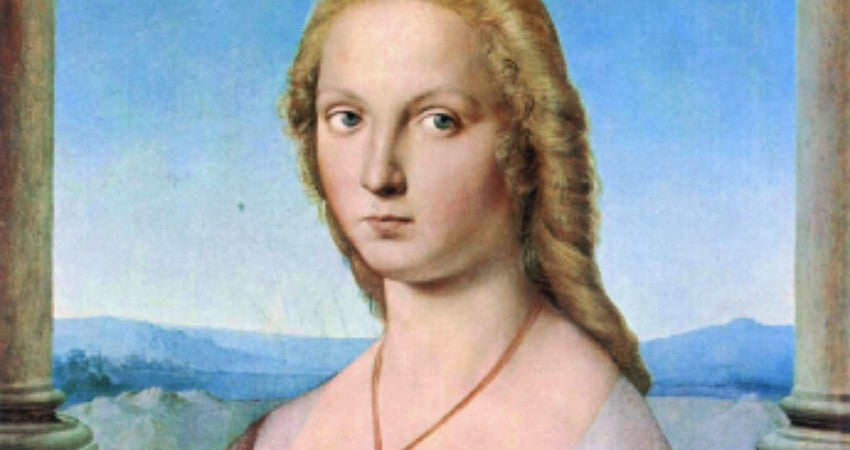
Restorations and Mysteries: The Hidden Story Behind Raffaello Sanzio's Lady with the Unicorn
Alice PettirossoShare
History of the Painting
The oil painting Lady with a Unicorn , painted by Raffaello Sanzio around 1505-1506, is preserved in the Galleria Borghese in Rome. The work appears in the Borghese inventories since 1760, but over time it has undergone various attributions. Before 1928, in fact, it was thought that the painting was the work of masters such as Perugino, Ridolfo del Ghirlandaio, Francesco Granacci or Andrea del Sarto. Only in 1928, thanks to the studies of Roberto Longhi, was it attributed with certainty to Raphael. This attribution was further confirmed during the restoration of 1935, when x-rays revealed that the figure was originally not holding the unicorn, or liocorno, symbol of virginal purity, but a small dog, symbol of marital fidelity.
Painting technique
From a technical point of view, the work is executed with the oil on panel technique, one of Raphael's favorites in that period, since it guaranteed an excellent rendering of details and an intense luminosity. The painting is distinguished by the delicacy and softness of the nuances that give the lady's face a serene and idealized aura.
Modifications and restoration
At the beginning of the twentieth century, the various hands that had contributed to altering some parts of the painting, added later to the original composition, were recognized. Before the restoration of 1935, the woman portrayed appeared as Saint Catherine of Alexandria, with her classic iconographic attributes, including the cogwheel and the palm. It was customary, at the time, to rework works of art for religious reasons or to satisfy the requests of clients. For The Lady with the Unicorn , the Borghese family's veneration for Saint Catherine would justify this transformation. The hands and the cloak were also added by another artist.
Identity of the portrayed lady
The identity of the woman portrayed remains a matter of debate among scholars. Some argue that it is Caterina Gonzaga di Montevecchio, celebrated in the Renaissance for her extraordinary beauty. According to this theory, after the death of her husband Ottaviano Gabrielli di Gubbio, Count of Montevecchio, and Caterina's subsequent retirement to a convent, the woman's features in the painting were modified to make her resemble Saint Catherine of Alexandria, with an obvious symbolic reference to her name. Other scholars hypothesize that the lady is Maddalena Strozzi, although this hypothesis is not confirmed. Another theory suggests that the lady portrayed is instead Giulia Farnese, lover of Pope Alexander VI, since the symbol of the unicorn is also associated with the Farnese family.
Iconographic description
The painting depicts a young woman sitting half-length, placed in front of a terrace adorned with columns. Her gaze is directed frontally towards the observer, a characteristic that recalls the influence of Leonardo, evident both in the intensity of the gaze and in the posture of the lady, with her hands embracing the animal, as in the pose of the Lady with an Ermine . However, Raphael replaces Leonardo's complex symbolism with a sober and refined elegance, centered on a meticulous attention to detail.
Clothing and unicorn details
The lady's clothing is typical of young noblewomen of the time: she wears a low-cut dress, with wide, laced sleeves, similar to that depicted in other works by Raphael, such as La Gravida , preserved in Palazzo Pitti. Her hair is blond, flowing, and decorated with a small jewel on her forehead, a diadem, while the hairstyle frames her face. The lady's blue eyes are directed towards a point that seems to be just behind the observer's shoulders, giving spatiality and mobility to the work. Around her neck she wears a gold chain with a pendant composed of a ruby and a drop-shaped pearl. In her arms she holds a small unicorn, a symbol of virginal purity, since, according to mythology, only virgins could tame that creature.
Confirmation of attribution
The attribution of the work to Raphael was not immediate. Only in 1928, thanks to the studies of Roberto Longhi, was definitive confirmation reached that the painting was the work of the master from Urbino. This attribution was consolidated during the restoration of 1935, which revealed not only the original presence of the small dog in place of the unicorn, but also the elegance and complete mastery with which Raphael had conceived the work.

